Before we left China we crossed the border to Hong Kong once again for the second opening there of “The Silent Strength of Liu Xia,” the exhibition of 26 photos by the dissident Chinese photographer, artist, and poet whose world tour I’m now enabling. After its two-week run at the City University of Hong Kong (June 9-23) the installation moved, in considerably reconfigured form, to the Hong Kong Arts Centre for a short extension of its presence in HK, June 25-July 2.
For this presentation the “behavioural artist” Sanmu repurposed most of the materials from the installation he’d designed for the Hong Kong debut of the show earlier this month. (Note: The term behavioural art, heretofore unknown to me, is synonymous with “performance art.”) It’s a more traditional yet still imaginative offering of the work. Most of the pictures now hang conventionally on the wall; half a dozen stand on a ledge in a viewing balcony.
But one — Liu Xia’s portrait of her husband, the imprisoned Nobel Peace Prize 2010 recipient Liu Xiaobo — occupies a small room that, lined with enlarged images of rocks (details from another of Liu Xia’s images) feels like a prison. There it sits on “The Empty Chair,” a sculptural work by the Dutch designer Maarten Baas created for Amnesty International to honor imprisoned writers and other cultural and political figures, and lent to this exhibition by AI. A looped audio recording of Jiang Zhizhong reading, in Chinese, Liu Xiaobo’s “Final Statement” — issued December 23, 2009, two days before he began serving his current 11-year sentence — functions as soundtrack for this now-charged space. The text of that powerful essay, in Chinese and English translation, hangs on the wall.
The program for the opening on the evening of June 25 began with short remarks by myself, representing the curatorial team behind the exhibit. It continued with commentary by Lee Cheuk Yan, a legislator and chairman of the Hong Kong Alliance in Support of Patriotic Democratic Movements of China (which holds the annual Tiananmen Massacre candlelight vigil in Hong Kong’s Victoria Park on June 4 every year); Rev. Chu Yiu Ming, an executive committee member of the Alliance; Mabel Au, Director of Amnesty International Hong Kong; and Patrick Poon, board member and Executive Secretary of the Independent Chinese PEN Center (ICPC), which sponsored and organized this Hong Kong leg of the tour of Liu Xia’s work.
This was followed by Xinyu and Jiang Zhizhong reading poems Liu Xiaobo and Liu Xia wrote to each other, with “behavioural art” performances by six Hong Kong artists after that: Him Lo, Leung Wai-Man, Vinci Mok, Chan Mei Tung, Ger Choi, and East Tung. Sanmu, present for the occasion, did not himself perform that night (as he had during the June 9 Hong Kong premiere), contenting himself with documenting the actions of the younger set.
These two Hong Kong presentations of the show emerged from a logistical crisis that prevented shipment from New York of the prints extracted from the mainland by Guy Sorman and shown first in Boulogne-Billancourt and then in Manhattan. That situation mandated rapid, inexpensive production of a second set of prints, while the display spaces available at the first Hong Kong site for the show, the City University of Hong Kong, made unconventional installation necessary. For further details on this showing of ”The Silent Strength of Liu Xia,” click here.
Earlier this year, even before leaving New York, I’d begun to design alternative formats for public presentations of Liu Xia’s images, approaches more versatile and inexpensive than the relatively conventional form shown to date in France and the U.S. Not with an eye toward abandoning museums and other such traditional venues, but with alternative spaces and platforms — photo festivals, cultural centers, etc. — in mind. I’d come up with several, which I expect to propose to prospective sites shortly.
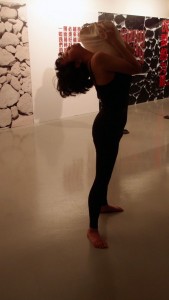
Chan Mei Tung, performance, Liu Xia installation, Hong Kong Arts Centre, June 25, 2012. Photo © by A. D. Coleman.
Sanmu’s design for CityU, a freestanding, modular framework, added to the list of possibilities. No less importantly, seeing his ideas actualized confirmed my impression that Liu Xia’s images, unlike many, can thrive and deliver their energies in any number of different presentational formats. Having seen two different versions of the catalogue, each with its own distinct production values, I think that’s no less true of these images’ appearance on the printed page than it is of their occupation of physical spaces. This allows a lot of latitude, and encourages a collaborative approach — between myself and the work, to begin with, and then between the work and other creative spirits like Sanmu.
Yet that puts me in a very odd position, curatorially speaking. Because Liu Xia now lives under house arrest, incommunicado save for periodic visits with her mother, I can’t run any such decisions past her, as I would automatically in organizing a show by a living artist. Having never met her, spoken with her, or corresponded with her, I can’t claim any privy knowledge of her druthers. I have only a few translated texts of her letters and statements, translations of a few of her poems, and these images to go on. Plus my knowledge of her situation, and her husband’s, and my limited understanding of the complexities of contemporary Chinese politics, culture, and artistic practice.
Thus I have to trust to my instincts, along with my sense of what I’d want others to do with my work if I were in her shoes. As I said in my curator’s remarks at these Hong Kong showings, “We look forward to attending, someday, the conclusion of this exhibition’s world tour at a venue in Beijing, with Liu Xia herself, and Liu Xiaobo, present.” On that occasion I’ll present her with a comprehensive record of what we’ve done with her work up to that point, and will gladly make myself fully accountable for any excesses and liberties taken.
•
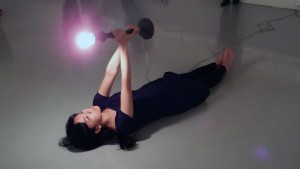
Ger Choi, performance, Liu Xia installation, Hong Kong Arts Centre, June 25, 2012. Photo © by A. D. Coleman.
Flying back to New York with Anna on June 27, I leave China with my usual mixed feelings. Fascinated, as always, to have had a chance to observe at first hand a dynamic culture in a state of constant flux. Impressed with the industriousness of the general populace — the hardest-working people I’ve ever spent time around. Concerned that the pandemic corruption historically deep-rooted in China’s official and unofficial sociopolitical structures will increase rather than decrease as those interbreed with the amoral logic of the free-enterprise system.
Plus a few new ones. Anxious for the brave souls we’ve met recently, who understand citizenship much as I do, and who stand ready and willing to speak truth to power. Relieved that we won’t be here for the next six months, which I anticipate will be difficult, volatile, and dangerous, as Wen Jiabao and Hu Jintao hand over their leadership of the Chinese Communist Party to . . . still unspecified others now fiercely battling for their scepters backstage, in a byzantine and opaque process of which the Bo Xilai scandal represents the merest tip of the iceberg. (Originally scheduled for September-October, the 18th National Congress of the Communist Party of China may get postponed while they deal with the fallout from this uproar.)
In the States, to be sure, during the coming months we’ll go through our own weird political process, which, culminating in November, will result in either the continuation of the Obama administration or the installation of our first president to believe in the Angel Moroni. Obama will have my vote, again, and if he wins the election and manages to perform as well in his second term as he had in his first he’ll leave office as the president for whom I’ve voted who disappointed me the least during his tenure. That would make Jimmy Carter, who currently holds that position (cheated out of his second term by the treason of Ronald Reagan) Obama’s runner-up, with Bill Clinton (hamstrung by his libido) in third place.
In my lifetime we’ve devolved into a mere facsimile of a democracy, a scary number of whose citizens would cheerfully swap the Bill of Rights for licenses to own as many guns as they can afford, a tryout for American Idol, the latest tweet on Lindsay Lohan, and the freedom to choose between McDonald’s, Burger King, KFC, Taco Bell, and Pizza Hut for lunch, but would never ever vote for a candidate who refused on principle to say “God bless America” at the end of a public address. Yet even if I deem the U.S.A. today the world’s biggest-ever banana republic, a culture in rapid and irreversible decline, I’d rather live there than anywhere else. Better the devil you know, I suppose.
Yet the fact is that, from our Staten Island home, I can download Gene Sharp’s From Dictatorship to Democracy (1993, 2002, and 2003; downloadable as a free e-book here), a handbook on nonviolent revolution that’s influenced people around the globe, and I can’t do that from our Shenzhen apartment — as good a gauge as any of the relative state of freedom of thought and expression in the two countries. YouTube is equally out of reach here, along with Facebook, Twitter, and others that crowdsource content. You can’t get Hulu. And, with no self-evident logic or predictability, specific stories at the sites of CNN, the BBC, the New York Times, and the Washington Post get blocked as well.
 From mainland China I also can’t access I Can Has Cheezburger? — or, to put a finer point on it, I can access the site but can’t view any of its content, all of its videos and still images blocked. Presumably not due to its subject matter (the Chinese have an appreciation of squee to match that of roundeyes), but because it represents user-uploaded content. Access to information (including, inevitably, access to misinformation, disinformation, and pap) remains one of my primary measures of my relative freedom in any situation. So I look forward to resuming the routines of our daily life in the cultural capital of our second-rate power.
From mainland China I also can’t access I Can Has Cheezburger? — or, to put a finer point on it, I can access the site but can’t view any of its content, all of its videos and still images blocked. Presumably not due to its subject matter (the Chinese have an appreciation of squee to match that of roundeyes), but because it represents user-uploaded content. Access to information (including, inevitably, access to misinformation, disinformation, and pap) remains one of my primary measures of my relative freedom in any situation. So I look forward to resuming the routines of our daily life in the cultural capital of our second-rate power.
•
This post supported by a donation from the Estate of Lyle Bongé.



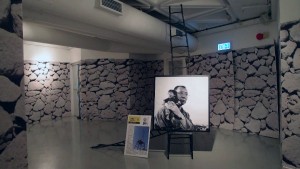
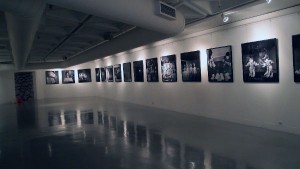
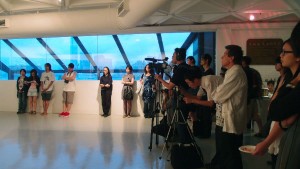

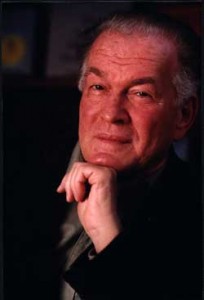




I will look forward to hearing from you… as I attempt to adjust the routines of my daily life in a cultural backwater of our second-rate power.